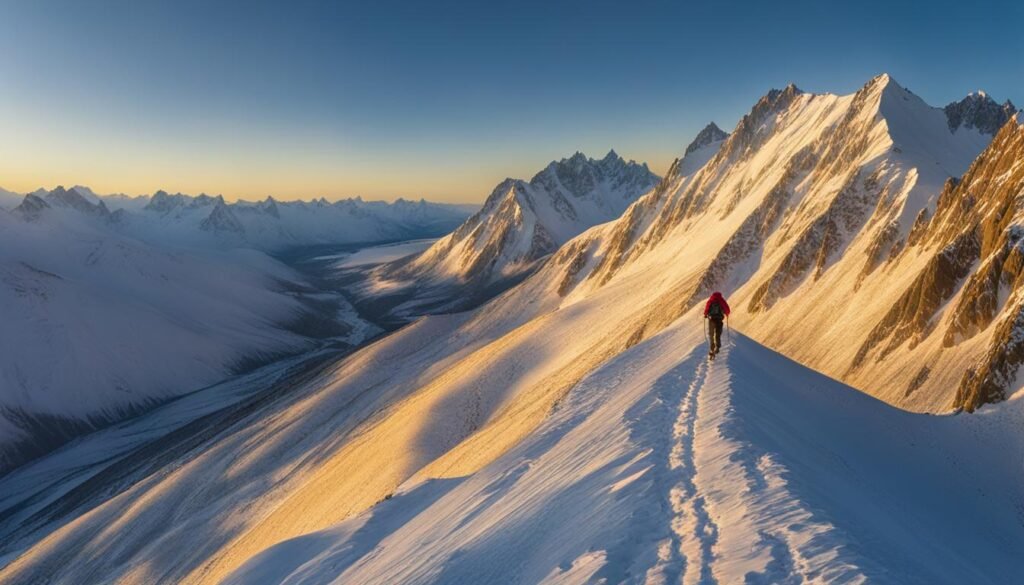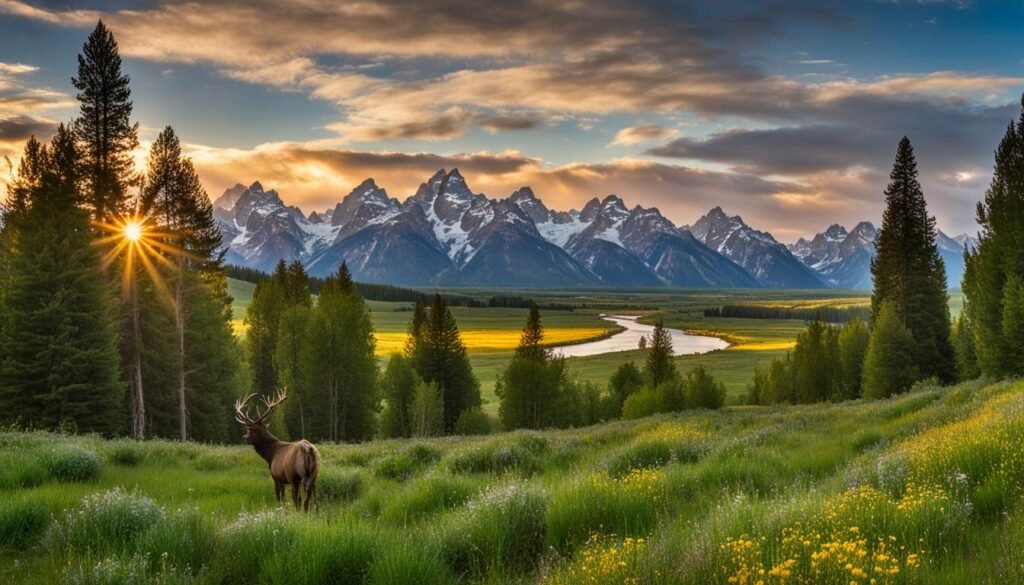For those who find their solace in the great outdoors, the quest for the perfect backpacking destinations is an ever-evolving journey. The United States presents a stunning array of opportunities, where scenic hikes converge with the serenity of off-the-beaten-path routes. Nature enthusiasts are invited to discover the restorative wonders of wilderness trails, interfusing the joy of hiking and camping with pure nature exploration.
Whether it’s the unparalleled peace found in remote landscapes or the thrill of navigating through unmarked terrain with the trust of your trail maps, seeking out the best backpacking routes for nature lovers promises a sense of escape, adventure, and connection. Join us as we unveil destinations where rolling mists and ancient forests set the scene for the ultimate outdoor adventures.
Rejuvenating Journeys: The Healing Power of Nature
For nature lovers seeking solace from the grind of everyday life, America’s rich tapestry of wilderness trails offers the quintessential environment for nature exploration. Here, amongst the great outdoors, a sense of wellbeing takes root, much as environmental pioneer John Muir intended when advocating for the creation of our national parks. Muir’s belief in the restorative powers of the wild underscores the essential role these parks play in contemporary outdoor adventures.
His legacy of environmental activism lives on, as adventurers reignite their connection with the natural world, trekking through terrains marked by the tranquility of sequoia giants or the sprightly streams on the sun-dappled forest floor. The breadth of experiences available to nature lovers is vast, with itineraries ranging from the serene to the strenuous, all promising catharsis and rejuvenation.
In every walk with nature, one receives far more than he seeks. – John Muir
From the sweeping views afforded by the peaks of the Kesugi Ridge to the introspective moments found along Vermont’s Long Trail, the call of the wild is unmistakable and unspoiled. The following table presents just a glimpse of the varied experiences adventurers might seek in their quest for peace and perspective, further illustrating the enduring wisdom of John Muir.
| Trail Name | Location | Trail Feature | Suitable For |
|---|---|---|---|
| Kesugi Ridge Trail | Alaska | Mountain Vistas | Solo and Group Hikers |
| Long Trail | Vermont | Solitary Splendor | Thru-Hikers |
| Yosemite’s Panorama Trail | California | Iconic Landscapes | Day Hikers |
| Teton Crest Trail | Wyoming | Rugged Beauty | Wildlife Enthusiasts |
Embodying the spirit of environmental activism, today’s hikers recognize their role in preserving these pristine spaces. They engage not only in personal reflection but also in the active conservation of the environments they cherish. Indeed, to venture onto America’s trails is to walk in the footsteps of John Muir, seeking both the intimate revelations and the grand affirmations that come from being one with nature.
Alaska’s Call of the Wild: Kesugi Ridge Trail
Trekking the Kesugi Ridge Trail invites robust wilderness trails enthusiasts to immerse themselves in the Alaska Mountains’ majesty. This sought-after hiking and camping journey epitomizes outdoor adventures, but it demands respect and readiness for the unpredictable Alaskan elements.
Preparing for Alaska’s Unpredictable Weather
Hikers planning to conquer the Kesugi Ridge Trail must equip themselves for the vagaries of Alaska’s climate. To help ensure a memorable and safe trek through the magnificent landscapes, here are some essential considerations:
- Track weather patterns ahead of time and be prepared for sudden changes.
- Summer and early fall typically offer milder weather and clearer trails.
- Keep abreast of trail access updates, as conditions can be altered by natural events such as flooding.
Wildlife Encounters: Staying Safe Among Bears
Encounters with Alaska’s wildlife, including bears, are not uncommon. Protecting oneself is crucial:
- Always carry bear spray and know how to use it effectively.
- Study bear behavior and be vigilant, especially when hiking in dense vegetation or near streams where bears may be present.
Navigating through Fog: Must-Have Gear
The Kesugi Ridge Trail’s beauty can be shrouded in fog, making navigation challenging:
- Carry a reliable compass as a navigational mainstay.
- Bolster your directional arsenal with up-to-date trail maps.
- Always let someone know your planned route and expected return time.

| Item | Importance | Notes |
|---|---|---|
| Weather-Appropriate Clothing | Essential | Includes layering options to adapt to changing conditions. |
| Bear Spray | Essential | A safety necessity for all hikers in bear country. |
| Compass and Maps | Critical | Required for foggy conditions and unexpected detours. |
| Communication Device | Highly Recommended | For emergency use and to update others on your status. |
Inspiring Vistas: Yosemite Valley’s Panorama Trail
For those who seek the unforgettable thrill of outdoor adventures, the Panorama Trail in Yosemite Valley stands as a beacon of natural grandeur. Recognized as one of the most scenic hikes within the United States, it beckons nature lovers with its stunning array of vistas and immersive wilderness.
Infusing every step with the essence of the great outdoors, this trail is not just a pathway but an experience—a gift to those who travel its course. Wrapping around iconic landmarks and vistas, the Panorama Trail offers sweeping views that encapsulate the beauty of the wilderness trails Yosemite is famous for. It’s an essential addition to any list of premier backpacking routes for nature lovers, challenging and rewarding in equal measure.
- A harmony of waterfalls and panoramic overlooks
- An encounter with Mother Nature’s artistry, from Illilouette Falls to the captivating Half Dome vista
- The allure of hiking amidst the splendor of seasonal wildflowers and vibrant wildlife
Indeed, Yosemite’s Panorama Trail epitomizes the spirit of the valley—a place where one’s soul can dance with the peaks and where the sky’s canvas melts into the Sierra Nevada’s rugged silhouette. So, lace up your boots, and step into the heart of an outdoor adventure that awaits amidst the revered paths of Yosemite.
Wyoming’s Teton Crest Trail: A Path of Majesty
Amidst the grandeur of the Rocky Mountains lies the Teton Crest Trail, a premier backpacking destination within the Grand Teton National Park. Known for its breathtaking vistas, meandering paths through alpine terrain, and remarkable wildlife encounters, this trail is a crown jewel for hikers and camping aficionados. Preparing for a trek along this majestic trail involves meticulous planning and a respect for the natural habitat you will enter.

Planning Your Grand Teton Adventure
Embarking on the Teton Crest Trail is not a spontaneous day trip but a true excursion into the wilderness heart of Wyoming. Key to a successful journey is anticipating the terrain, which ranges from verdant valleys to craggy peaks, and demands both physical and mental preparation. The weather can swiftly shift from sunny to inclement, underscoring the importance of being equipped for rapid changes in conditions. A thoughtful approach to route planning, considering variables such as campsite selection, trail length, and elevation changes, will help ensure a safe and exhilarating experience hiking and camping in this rugged landscape.
Why Bearing Bear Spray is Essential
Venturing into Grand Teton National Park means sharing space with its natural residents, including bears. Bear spray becomes as vital as your hiking boots when preparing for wildlife encounters on the trail. As one of the most effective deterrents, it is essential to not only carry it but also know how to use it responsibly. Understanding bear behavior, maintaining a safe distance, and keeping food secured are further measures that enhance protection for both hikers and the majestic creatures that inhabit the Grand Teton National Park.
As wildlife encounters are common, hikers must prioritize their safety and the preservation of the park’s ecosystem. Whether traversing forested paths, open meadows, or ascending to panoramic overlooks, the partnership of preparation and reverence for the natural world will transcend any hiker’s adventure on the Teton Crest Trail.
Maine’s Appalachian Trail: The Call of Primitive Wilderness
The Appalachian Trail in Maine stands as a testament to the untamed heart of the East Coast’s famed wilderness areas. Embracing the true sense of adventure, this segment of the trail provides backpacking routes for nature lovers that create an intimate connection with the raw, natural world. Traversing this landscape offers a unique blend of challenges and visual rewards, with stunning scenic hikes that attract hikers and camping enthusiasts from around the world.
The Challenges and Beauty of the 160.9 km Wilderness
The Maine portion of the Appalachian Trail, spanning an impressive 160.9 km of uninterrupted wilderness, is a paradise for those looking to delve deep into the Maine Wilderness. This rugged expanse, free from the interruption of paved roads, is both gloriously scenic and demanding. For those embarking on this journey, expect to weave through dense forests, climb across rocky outcroppings, and behold panoramic vistas that encapsulate the trail’s magnificence. A combination of physical endurance and mental fortitude is crucial for those seeking to fully immerse themselves in this unique outdoor experience.
Lush Vistas at Lower Wilson Falls
Among the Appalachian Trail’s numerous highlights in Maine, Lower Wilson Falls is a natural cornerstone that captivates every hiker that lays eyes on it. The falls present a picturesque scene, with water cascading energetically down the rocky escarpment surrounded by thickets of verdant trees. These lush vistas provide a tranquil environment for hikers to rest and reflect amid the intrinsic beauty of the trail before continuing on their scenic hikes through the Maine Wilderness. Lower Wilson Falls exemplifies the enriching experiences that backpacking routes for nature lovers offer, with the sound of rushing water resonating as a serene backdrop to an unforgettable adventure.
New Hampshire White Mountains: The Allure of the Pemi Loop
The Pemigewasset Wilderness, nestled in the heart of the White Mountains, is home to one of the most captivating high elevation treks—a journey known as the Pemi Loop. This renowned loop lures adventurers with its rigorous paths and stunning panoramas, offering an unforgettable experience for those seeking the thrill of outdoor adventures in one of the Northeast’s premier backpacking destinations.
High Elevations and the Dance of the Weather
Ascending the Pemi Loop is a true test of a hiker’s endurance and will, with trails winding their way through multiple peaks that soar over 1,219 meters. Preparation is paramount, as the mountain’s mood swings from sunny skies to brooding overcasts in a blink. The ever-dancing weather demands respect, making it a necessity to pack for all eventualities before embarking on the wilderness trails of the White Mountains.

Guidelines for a Safe Hiking Experience
Navigating the Pemi Loop safely necessitates a keen awareness and readiness for White Mountains’ unpredictable climate and rugged terrain. To ensure a secure passage, here are some essential guidelines:
- Always check the weather forecast before heading out to anticipate changes in conditions.
- Equip yourself with a detailed map, compass, and the knowledge of how to use them—technological devices may fail in remote areas.
- Consider the local fauna, including black bears, and carry bear spray as a precautionary measure.
- Wear appropriate clothing and footwear for the undulating and sometimes treacherous paths.
- Carry a sufficient supply of food and water, as well as a water purification method.
- Never hike alone; sharing the journey not only enhances safety but the overall experience.
With thorough preparation and a respect for nature’s elements, hikers can immerse themselves in the majesty of the Pemigewasset Wilderness, creating memories on the high elevation trails that will last a lifetime.
Utah’s Highline Trail: Solitude of the Uintas
Embark on a journey across the majestic Highline Trail and immerse yourself in the solitude of the Uinta Mountains. This remote wilderness experience is for those who yearn to explore serene lakes, encounter an array of wildlife, and traverse through some of nature’s most stunning off-the-beaten-path routes.
The Highline Trail serves as a true testament to the spirit of adventure. Backpackers seeking a demanding journey will find both challenges and rewards in the vast expanses of these high-elevation Uintas. Noteworthy are the trail’s serene lakes, which reflect the sky like vast mirrors, providing a tranquil spot for rest and reflection amidst the rugged demands of the trail.
- **Wilderness Experience**: A true sense of wilderness envelops each step on the Highline Trail.
- **Nature Exploration**: From dense pine forests to open alpine vistas, the trail offers a chance for intimate nature exploration.
- **Serene Lakes**: Scattered like jewels, the lakes are a highlight, offering peaceful interludes during the hike.
- **Wildlife Encounters**: Be prepared to spot the local inhabitants in their natural habitat; a reminder you are just a guest in their wilderness home.
Respect for the natural environment and its inhabitants is paramount. The Quiet of the Uintas commands reverence, a place where one can listen to the whispering winds and the chatter of wildlife, far from the sounds of civilization.
| Highline Trail Features | Benefits |
|---|---|
| Off-the-beaten-path adventuring | Exclusivity and solitude |
| Remote wilderness access | Unfiltered engagement with nature |
| Diverse terrain | Enriching and varied hiking experience |
| Wildlife habitats | Opportunities for rare animal sightings |
| Breathtaking scenery | Memorable photographic moments |
Whether you seek the solitude of the wilderness or a deep dive into nature exploration, Utah’s Highline Trail in the Uinta Mountains is an unforgettable adventure. Prepare well, leave no trace, and the Highline will gift you an experience like no other, where every trail turn promises a new perspective of our planet’s profound beauty.
Experiencing the Wonderland Trail at Mount Rainier
The Wonderland Trail is a prime example of the outdoor adventures that beckon nature enthusiasts to Mount Rainier National Park. This esteemed backpacking destination offers one of the most scenic hikes in the Pacific Northwest, showcasing the wilderness trails that wind through this iconic landscape.

Navigation and Permits: Essential Tips for Campers
Navigating the Wonderland Trail’s vast stretch means confronting a 150 km journey featuring unpredictable terrain and breathtaking elevation shifts. Obtaining crucial permits and up-to-date navigational information is critical for the modern backpacker. Hikers must reserve designated wilderness campsites in advance, a testament to the trail’s popularity and strict conservation practices. Here’s a quick guide:
| Permit Type | Acquisition Method | Notable Restrictions |
|---|---|---|
| Wilderness Permit | In-Person/Online Lottery | Required for overnight stays |
| River Crossing Permit | In-Person at Ranger Stations | Necessary for certain river areas |
| Special Campsite Reservations | Advance Reservation System | Limited availability during peak season |
| Day Hike Pass | Not Required | Applies to day hikers only |
Remember, the Wonderland Trail isn’t just an outdoor trek—it’s an encounter with protected ecosystems that require our respect and mindfulness.
The Rich Ecosystem of the Cascades
The trails of Mount Rainier National Park’s Wonderland are more than just paths—they are corridors through diverse ecological zones. With each step along this intricate network, backpackers are invited to experience the rich biodiversity of the Cascades. From temperate rainforests to subalpine meadows that burst with wildflowers in late summer, the dynamic microclimates keep even the most seasoned hikers engaged.
Here’s a snapshot of what to expect:
- Lush forests with ancient Douglas firs and red cedars.
- Meadows that explode with color as wildflowers bloom.
- Rugged peaks juxtaposed with serene glacial lakes.
- Observations of wildlife in their natural habitats.
Getting prepared for diverse weather on the Wonderland Trail, ranging from sun-kissed meadows to fleeting snow flurries at higher altitudes, is crucial. This outdoor adventure isn’t just a physical journey, but a holistic experience that fosters a deep appreciation for nature’s ever-changing canvas.
Colorado Rockies: The Four Pass Loop
Embarking on the Four Pass Loop through Colorado’s iconic Maroon Bells-Snowmass Wilderness is an unforgettable journey for those seeking the thrill of rugged mountain peaks and the beauty of alpine meadows. Offered as one of the premier backpacking routes for nature lovers, this trail challenges adventurers with its high-altitude passes and rewards them with breathtaking vistas.
Confronting the Altitude: Best Time to Trek
To fully embrace the outdoor adventures that the Four Pass Loop has to offer, one must consider the timing of their trek carefully. The route involves crossing four distinct mountain passes, each rising over 3,658 meters. Late summer to early fall presents the most favorable conditions to tackle these heights, when the weather is more stable, and the risks associated with snowmelt-induced river crossings are minimized. Preparedness for the changes in elevation is key to an enjoyable and safe hiking experience.
Maroon Bells Wilderness: Where Alpines Bloom
The journey through the heart of the Maroon Bells-Snowmass Wilderness is an immersion in nature’s grandeur, featuring alpine meadows scattered with a colorful quilt of wildflowers. The path’s rugged terrain is complemented by the serene beauty of the area, providing an incredible backdrop for a three to four-day trek. Hikers will find the natural mountain amphitheater formed by the Maroon Bells to be among the most stunning landscapes, an essential destination for any nature enthusiast’s bucket list.
To assist in successful planning, here is a table with key information you should know before heading out on the Four Pass Loop:
| Trek Feature | Details |
|---|---|
| Elevation of Passes | Over 3,658 meters each |
| Best Trekking Period | Late Summer to Early Fall |
| Typical Duration | 3-4 Days |
| Wildlife Precautions | Certified Bear-resistant Food Storage |
| Floral Highlights | Alpine Meadows with Wildflowers |
| Scenery | Rugged Peaks and Tranquil Valleys |
Explorers looking to ascend the summits and traverse the valleys of the Four Pass Loop will be met with a true testament to the beauty of the Colorado Rockies. By equipping themselves with knowledge of the terrain and respect for the delicate ecosystem, they can ensure their outdoor adventure becomes a treasure trove of memories amidst the wilderness.
California’s Rugged Coast: Lost Coast Trail Insights
The call of the wild is incarnate along the Lost Coast Trail, a premier backpacking route for nature lovers. It is a journey of pure discovery, with golden sunsets reflected on mirror-like tide pools and seaside meadows bursting to the thrum of the Pacific. For those who seek outdoor adventures, there’s nothing quite like the remote and rugged wilderness trails of California’s northern coastline.
The 40 km odyssey stands apart as one of the few coastal wilderness experiences available in the United States—entirely inaccessible by road, it promises seclusion and unspoiled beauty. This scenic hike is not just a walk alongside the ocean; it is an ever-changing landscape of beaches and mountain ridges where the land bravely meets the sea. Essential to the experience is an awareness of the tides; the beach paths present in low tide can vanish completely under the high tide, necessitating careful planning.
The Lost Coast Trail offers a hiking and camping experience like no other. It’s a land forgotten by time, preserved for the footsteps of the ambitious wanderer.
- Navigate the shores and forests, always with a careful eye on the sea.
- Prepare to traverse soft sands and pebbled beaches, which challenge even seasoned hikers.
- Equip yourself with bear canisters—a must for protecting your provisions as well as the natural ecosystem.
The isolation of this outdoor adventure enhances its appeal. Far from the nearest cell tower, you converse with the elements, listening to what the wind, waves, and wildlife have to say. But with this remoteness comes the responsibility for rigorous preparation. Seasons matter here: July and August are best, with clearer paths beneath your feet and fewer rainclouds above.
For those who answer the call of the Lost Coast Trail, the rewards are immeasurable. Even in a state known for its stunning landscapes, this trail is a crown jewel, a reminder of the rugged wildness that once spanned the coast. Whether you seek solitude, challenge, or the simple joy of seaside scenic hikes, this trail awaits with promises of untold splendor and adventures.
Vermont’s Green Mountains: Long Trail Adventures
As you set foot in Vermont, the allure of the oldest long-distance trail in the United States beckons. The Long Trail, a beacon among backpacking destinations, weaves through the heart of the Green Mountains, presenting an array of scenic hikes unparalleled in their beauty and ruggedness. A blend of ancient hardwood forests, alpine sedge, and majestic peaks creates a backdrop for an unforgettable trekking experience.
Hiking America’s Oldest Long-Distance Trail
Spanning over 430 km, the Long Trail invites adventurers to traverse landscapes rich with history and natural splendor. From the scenic southern reaches near the Massachusetts border to the deep northern forests abutting Canada, this path delivers a continuous promise of discovery. As America’s first long-distance hiking trail, it has been a harbinger for the nation’s outdoor enthusiasts seeking to indulge in the pleasures of backcountry exploration.
Backcountry Campsites and Side Trails
Along the Long Trail, hidden gems await those willing to venture beyond its central artery. A network of side trails, totaling nearly 300 km, extends like tendrils into the wilderness, guiding hikers to secluded backcountry campsites. Here, in the solitude of Green Mountains’ untouched expanses, the true essence of rugged peaks and nature’s serenade may be found. Such pristine conditions, while idyllic, require respect for the land and preparation for the whims of mountain weather, ensuring each adventurer’s journey is not only challenging but also safe and deeply rewarding.
International Escapades: Beyond America’s Trails
When the wanderlust stirs within the hearts of nature enthusiasts, international backpacking destinations call out with whispers of ancient trails and breath-taking sceneries. Beyond the well-trod paths of the United States lie adventures that combine the allure of the outdoors with rich cultural undertones, making every step an exploration into the unknown.
Europe’s Peaks: The Swiss Alps Adventure
The Swiss Alps are synonymous with stunning scenery, offering some of the most picturesque scenic hikes known to outdoor adventurers. Here, the natural splendor of towering mountains meets the charm of Alpine culture. Nature enthusiasts can set up tents under a blanket of stars or choose the warmth of picturesque mountain huts after a day of hiking and camping. It’s a place where landscape and culture blend seamlessly, offering international tourists a multi-faceted experience.
Cultural Treks: The Great Wall of China’s Lesser-Known Paths
The Great Wall of China stands as an emblem of historical significance and a bucket-list destination for cultural treks. Venturing along its lesser-known paths allows hikers to meander through history’s silent stories while simultaneously indulging in the rugged beauty of China’s natural landscape. These remote backpacking journeys provide an intimate setting to connect with both past and present.
| Adventure | Activity Highlights | Cultural Elements | Nature Highlights |
|---|---|---|---|
| Swiss Alps Trekking | Alpine hiking, overnight in mountain huts, glacier tours | Local cuisine, traditional Swiss villages, Alpine cheese making | Snowcapped peaks, waterfalls, wildflower meadows |
| Great Wall of China Hiking | Exploration of ancient ramparts, secluded village paths | Interaction with local villagers, historical monument insights | Panoramic landscapes, wild flora and fauna |
Conclusion
The journey across diverse terrains, from the unyielding solitude of Alaska’s Kesugi Ridge to the dramatic coastlines of California’s Lost Coast, beckons the hearts of adventure seekers and nature enthusiasts. These backpacking routes for nature lovers provide much more than just scenic hikes; they offer a retreat into the essence of wilderness trails that sails beyond the ordinary, into a profound engagement with nature’s magnificence. Armed with trail maps and a spirit for nature exploration, backpackers find themselves woven into the tapestry of the natural world, discovering landscapes that resonate with the very rhythm of life.
Outdoor adventures evoke a certain magic, a unique blend of challenge and tranquility that infuses the soul with vitality. Whether it’s the quest for serenity among the rustic alpine charm of the Swiss Alps or the rugged peaks of Colorado’s Four Pass Loop, these backpacking destinations serve as gateways to transformative experiences. Hiking and camping along these wilderness trails, one cannot help but forge a deeper connection with the environment and an appreciation for the vast beauty that dwells in remote corners of the planet.
As the final words of this exploration of globetrotting trails are penned, it is clear that the quest for adventure is an enduring call to reconnect with the wild. The paths we choose to travel are as diverse as the destinations themselves, yet each step taken is a shared in pursuit of an exhilarating freedom found only in the embrace of Earth’s wild beauty. To the many who will set forth on these journeys, may your trails be ever scenic, your adventures grand, and your spirits forever enlivened by the wonders of the great outdoors.


